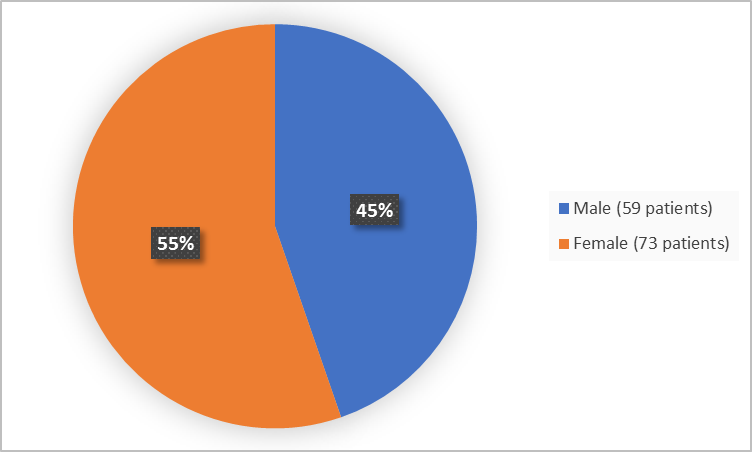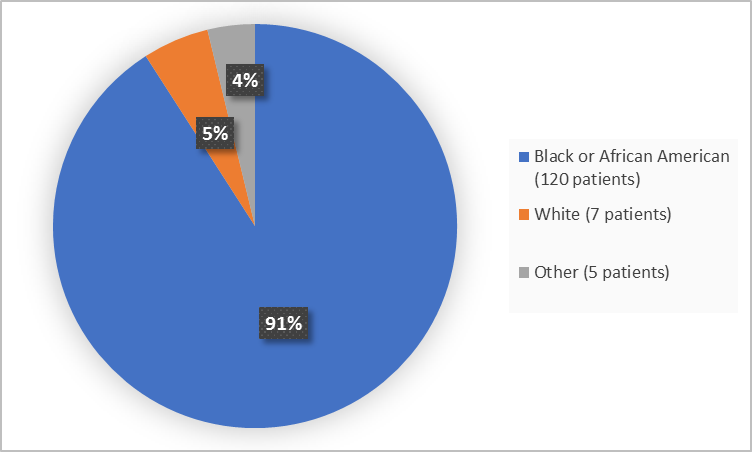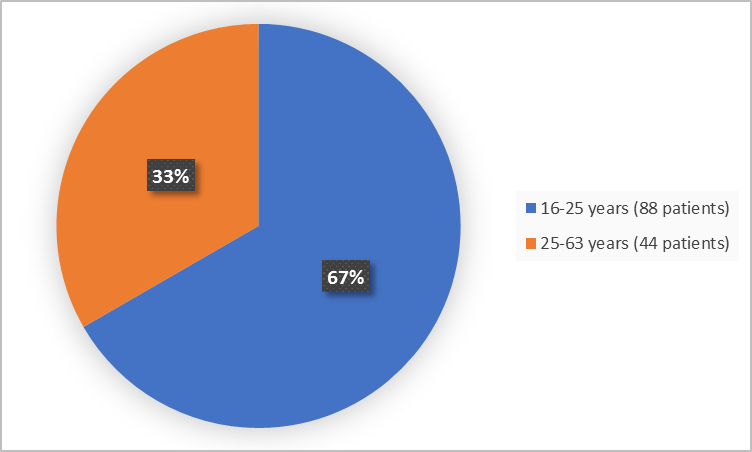Drug Trials Snapshots ADAKVEO
HOW TO USE THIS SNAPSHOT
The information provided in Snapshots highlights who participated in the clinical trials that supported the FDA approval of this drug, and whether there were differences among sex, race and age groups. The “MORE INFO” bar shows more detailed, technical content for each section. The Snapshot is intended as one tool for consumers to use when discussing the risks and benefits of the drugs.
LIMITATIONS OF THIS SNAPSHOT:
Do not rely on Snapshots to make decisions regarding medical care. Always speak to your health provider about the risks and benefits of a drug. Refer to the ADAKVEO Package Insert for complete information.
ADAKVEO (crizanlizumab-tmca)
ah dak vee oh
Novartis Pharmaceuticals Corporation
Approval date: November 15, 2019
DRUG TRIALS SNAPSHOT SUMMARY:
What is the drug for?
ADAKVEO is used to reduce the frequency of certain crises episodes (called vaso-oclusive crises) in patients 16 years of age and older who have sickle cell disease.
Sickle cell is an inherited blood disorder in which the red blood cells are abnormally shaped (in a crescent or "sickle" shape). Vaso-oclusive crisis (VOC) is a common and painful complication of sickle cell disease that occurs when blood circulation is obstructed by sickled red blood cells leading to severe pain and organ damage.
How is this drug used?
ADAKVEO is given by a healthcare provider directly into the vein (intravenous infusion) over 30 minutes. First two infusions are given 2 weeks apart followed by an infusion every 4 weeks thereafter.
What are the benefits of this drug?
Patients treated with ADAKVEO experienced fewer health care visits for VOC per year (about 1.63 visits), compared to patients who received a placebo (about 2.98 visits).
What are the benefits of this drug (results of trials used to assess efficacy)?
Efficacy of ADAKVEO was evaluated by the annual rate of VOCs leading to a healthcare visit. A healthcare visit is defined as an acute episode of pain with no cause other than a VOC event that required a patient be taken to a medical facility and was treated with oral or parenteral opioids, or parenteral NSAIDs.
Table 1. Efficacy Results from Trial 1 in Sickle Cell Diseasea
|
Event |
ADAKVEOb (n = 67) |
Placebob |
Treatment Difference Estimatec |
|
Annual rate of VOCa |
1.63 |
2.98 |
HL = -1.01, (-2.00, 0.00) |
|
Annual rate of days hospitalized |
4 |
6.87 |
|
HL, hodges-lehmann; VOC, vasoocclusive crisis
aVOCs were as assessed by an independent review committee
bStandard median
cHL median difference [95% confidence interval (CI)]
ADAKVEO Prescribing Information
Were there any differences in how well the drug worked in clinical trials among sex, race and age?
- Sex: ADAKVEO worked similarly in males and females.
- Race: The majority of patients were Black or African Americans. The number of patients in other races were limited; therefore, differences in how ADAKVEO worked among races could not be determined.
- Age: The majority of patients were adults between 18-63 years of age. There were not enough patients older than 65 years to determine whether there was any difference in how ADAKVEO worked between older and younger patients.
Were there any differences in how well the drug worked in clinical trials among sex, race, and age groups?
Subgroup efficacy analysis was performed only on sex groups because most patients were Black or African Americans between 18-63 years of age.
Table 2. Primary Endpoint Analysis by Sex (Intent-to-Treat population-ITT)
|
ITT Population |
ADAKVEO (N=67) |
Placebo (N=65) |
|
Male, n (%) |
32 (47.8) |
27 (41.5) |
|
Standard median |
2.50 |
2.00 |
|
1Median difference, (95% CI) |
-0.02, (-1.98, 1.02) |
--- |
|
Female, n (%) |
35 (52.2) |
38 (58.5) |
|
Standard median |
1.18 |
3.00 |
|
1Median difference, (95% CI) |
-1.93, (-3.00, -0.75) |
--- |
Adapted from FDA Review
What are the possible side effects?
ADAKVEO may cause serious infusion-related reactions and platelet clumping.
Most common side effects of ADAKVEO include nausea, joint pain, back pain and fever.
What are the possible side effects (results of trials used to assess safety)?
The table below summarizes adverse reaction in the Trial 1.
Table 3. Adverse Reactions (≥ 10%) in Patients Receiving ADAKVEO With a Difference Between Arms of > 3% Compared to Placebo in Trial 1
|
Adverse Reactions |
ADAKVEO |
Placebo |
||
|
All Grades |
Grade ≥ 3 |
All Grades |
Grade ≥ 3 |
|
|
Gastrointestinal Disorders |
||||
|
Nausea |
12 (18) |
0 |
7 (11) |
1 (2) |
|
Musculoskeletal and Connective Tissue |
||||
|
Arthralgia |
12 (18) |
1 (2) |
5 (8) |
1 (2) |
|
Back pain |
10 (15) |
0 |
7 (11) |
0 |
|
General Disorders and Administration Site |
||||
|
Pyrexia |
7 (11) |
1 (2) |
4 (7) |
0 |
ADAKVEO Prescribing Information
Were there any differences in side effects among sex, race and age?
- Sex: The occurrence of side effects was similar between males and females.
- Race: The majority of patients were Black or African Americans. The number of patients in other races were limited; therefore, differences in how ADAKVEO worked among races could not be determined.
- Age: The majority of patients were adults between 18-63 years of age. There were not enough patients older than 65 years to determine whether there was any difference in side effects between older and younger patients.
Were there any differences in side effects of the clinical trials among sex, race, and age groups?
Subgroup differences in adverse events between males and females is presented below. Race and age subgroups were not analyzed because most of the patients were Black or African Americans and between 18-63 years of age.
Table 4. Adverse Events by Sex
|
Adverse Event |
Safety Population
|
||||
|
Male |
Female
|
||||
|
ADAKVEO |
Placebo |
ADAKVEO |
Placebo (n=36) |
||
|
Any TEAE, n (%) |
26 (81.3) |
23 (88.5) |
31 (91.2) |
32 (88.9) |
|
|
≥ Grade 3, n (%) |
7 (21.9) |
5 (19.2) |
5 (14.7) |
7 (19.4) |
|
|
SAE, n (%) |
8 (25) |
5 (19.2) |
9 (26.5) |
12 (33.3) |
|
WHO WAS IN THE CLINICAL TRIALS?
Who participated in the clinical trials?
The FDA approved ADAKVEO based on evidence from one clinical trial (Trial 1/NCT01895361) of 132 patients with SS diseases who had a history of VOC. The trial was conducted at 60 sites in the United States, Brazil and Jamaica.
Figure 1 summarizes how many men and women were in the clinical trial.
Figure 1. Baseline Demographics by Sex
FDA Review
Figure 2 summarizes the percentage of patients by race in the clinical trial.
Figure 2. Baseline Demographics by Race
FDA Review
Figure 3 summarizes the percentage of patients by age in the clinical trial.
Figure 3. Baseline Demographics by Age
FDA Review
Who participated in the trials?
Demographics of trial participants are presented below.
Table 5. Baseline Demographics (Efficacy Population-ITT)
|
Demographic Parameters |
ADAKVEO |
Placebo (N=65) |
TOTAL |
|
Sex |
|
|
|
|
Male |
32 (47.8) |
27 (41.5) |
59 (44.7) |
|
Female |
35 (52.2) |
38 (58.5) |
73 (55.3) |
|
Race |
|
|
|
|
Black or African American |
60 (89.5) |
60 (92.3) |
120 (91) |
|
White |
4 (6) |
3 (4.6) |
7 (5.3) |
|
Other1 |
3 (4.5) |
2 (3.1) |
5 (3.7) |
|
Age |
|
|
|
|
Mean years (SD) |
30.9 (10.89) |
29. 3 (10.36) |
30.1 (10.6) |
|
Median (years) |
29 |
26 |
28 |
|
Min, max (years) |
16, 63 |
16, 56 |
16,63 |
|
Age Group |
|
|
|
|
16-25 years |
47 (70.1) |
41 (63.1) |
88 (66.7) |
|
25-63 years |
20 (29.9) |
24 (36.9) |
44 (33.3) |
|
Ethnicity |
|
|
|
|
Hispanic or Latino |
20 (29.9) |
11 (16.9) |
31(23.5) |
|
Not Hispanic or Latino |
45 (67.2) |
53 (81.5) |
98 (74.2) |
|
Unknown |
2 (3) |
1 (1.5) |
3 (2.3) |
|
Region |
|
|
|
|
US |
46 (68.7) |
53 (81.5) |
99 (75) |
|
Brazil/Jamaica |
21 (31.3) |
12 (18.5) |
33 (25) |
1Includes Mixed and Multiracial
Adapted from FDA Review
How were the trials designed?
There was one trial that evaluated the benefit and side effects of ADAKVEO in patients with SS disease. Patients had to have a history of 2-10 VOCs in the previous 12 months. Patients received at random either ADAKVEO or placebo infusions. The first two infusions were given 2 weeks apart followed by an infusion every 4 weeks. Trials lasted 52 weeks. Nether the patients not the healthcare providers knew which treatment had been given until the end of the trial.
The benefit of ADAKVEO was assessed by counting the number of VOCs healthcare visits that required pain treatments over a 1-year period.
How were the trials designed?
The efficacy and safety of ADAKVEO were evaluated in patients with sickle cell disease in a 52-week, randomized, multicenter, placebo-controlled, double-blind trial. Patients had various SS genotypes (HbSS, HbSC, HbS/beta0-thalassemia, HbS/beta+-thalassemia, and others), and a history of 2-10 VOCs in the previous 12 months. Patients received ADAKVEO or placebo administered over a period of 30 minutes by intravenous infusion on Week 0, Week 2, and every 4 weeks thereafter for a treatment duration of 52 weeks.
Efficacy was evaluated by the annual rate of VOCs leading to a healthcare visit defined as an acute episode of pain with no cause other than a vaso-occlusive event that required a medical facility visit and treatment with oral or parenteral opioids, or parenteral NSAIDs.
GLOSSARY
CLINICAL TRIAL: Voluntary research studies conducted in people and designed to answer specific questions about the safety or effectiveness of drugs, vaccines, other therapies, or new ways of using existing treatments.
COMPARATOR: A previously available treatment or placebo used in clinical trials that is compared to the actual drug being tested.
EFFICACY: How well the drug achieves the desired response when it is taken as described in a controlled clinical setting, such as during a clinical trial.
PLACEBO: An inactive substance or “sugar pill” that looks the same as, and is given the same way as, an active drug or treatment being tested. The effects of the active drug or treatment are compared to the effects of the placebo.
SUBGROUP: A subset of the population studied in a clinical trial. Demographic subsets include sex, race, and age groups.



